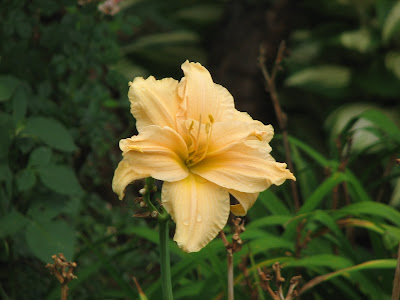Low Maintenance Plants
Plant Name: Hemerocallis hybrida
Overall Low Maintenance Rating: 4.5 Stars
Overview
One low maintenance perennial I couldn’t manage without is the Hemerocallis, or daylily. When they think of daylilies, many people think only of the bright orange ditch lilies found along every roadside or the interminable gold-colored ‘Stella D’Oro’, usually surrounded by a sea of red mulch. I have to admit that if these were the only choices available, I would banish them without ceremony from my garden. In the first instance, ditch lilies can actually become an invasive nuisance as they spread enthusiastically by root and seed. In the second instance, well, red mulch really SHOULD be banned; ‘Stella’ is OK but much overused.
Daylilies actually come in almost every color except blue and true black, and in a variety of sizes, from delicate dwarfs to towering giants. They can go years without division and are untouched by disease or pests in most areas. Bloom starts in late June and usually runs through July and into the early part of August. When not in bloom, they do a wonderful impression of a decorative grass.
Disease 4.5 Stars
In the Northeast, daylilies are relatively unaffected by disease. As you move south, however, daylily rust becomes an issue. Rust is a disfiguring fungus that has only recently been reported in the US. If you live in zone 7 or warmer, you may want to check out the information available at the American Hemerocallis Society’s (AHS) website on prevention and control. Rust looks like raised, orange bumps on the undersides of leaves and can result in the death of the leaf. While it does not seem to kill the plant outright, rust could weaken the plant and leave it susceptible to other problems. Spring sickness is a disorder I have seen in my garden and, while it is disconcerting, my plants have always outgrown it and take no lasting damage. When the plants first start sprouting in the spring, the leaves can twist and turn brown on the edges. It looks a bit like your plant is trying to fold itself into a ball! There is no known cause, though some theorize it may have to do with changing temperatures. The AHS website also shows pictures of this disorder. Pests – Insects 4.5 Stars
Insects generally leave daylilies alone or at least don’t do lasting damage. There are, however, bugs which do cosmetic damage to the flowers. Thrips cause white splotches and streaks on daylily flowers. Good luck spotting them as they are all but microscopic. Dark colored daylily flowers, reds and purples, show the damage the worst. I don’t find the damage sufficient to resort to sprays, but I’m told they can be controlled by products containing spinosad.
 |
| 'Startle' showing thrip damage |
There are other insects which can affect daylilies, but I cannot comment on them as I have not had problems with them (knock wood).
Pests – Animal 5 Stars
The only animal pests that have affected my daylilies have been voles. Horrible critters. Voles generally eat the roots of any garden plant you currently love. For some reason, though, they don’t like daylily roots. Instead, they undermine the plant and make little vole living rooms under them. The whole center of the plant will die since its roots are not touching soil. If you notice this happening, dig the plant up, destroy the tunnels and replant it, packing the dirt down firmly.
Also, get a cat. They help a lot.
 |
| I'm not as lazy as I look! |
Invasiveness 5 Stars
Domesticated daylilies are not invasive. The clumps expand politely and usually only need division every 3 to 4 years. The wild orange ditch lilies (hemerocallis fulva), on the other hand, can become quite the nuisance. They seed readily and expand wildly.
General Maintenance – Water 5 Stars
I’m about as lazy as it gets about watering. Unless a plant is in a pot and gasping its last breath, I am not likely to break out the hose. The daylilies absolutely don’t care. During the 3 weeks without rain and temps in the 90s, they were about the only plants which shrugged it off. This was during peak bloom time, too.
Please note that does not include newly planted daylilies; or any other baby plants, for that matter. Newly planted greenery should always be treated with extra care which includes making sure they never dry out. Once they’re established, they’re on their own.
General Maintenance – Fertilizing 5 Stars
Not once in the years I’ve been growing daylilies have I fertilized them. In theory, they might do better if I did, but I can’t see how!
General Maintenance – Pruning/Cleaning 4 Stars
Daylilies do require a little clean up on a regular basis to look their best, especially when they are flowering. Each flower only lasts one day and nothing is more disgusting than daylily flowers the day AFTER they flower. They turn to mush and then dry up and stick to the buds waiting to open. Picking the spent flowers off keeps it looking neat and the remains can be added to the compost heap. It’s not absolutely necessary, though, especially if you have lots of them!
Here are some of my favorites:
 |
| Armenian Haberdashery |
 |
| Wild Horses |
 |
| Frans Hall |
 |
| Monterey Jack |
 |
| Scatterbrain |








































